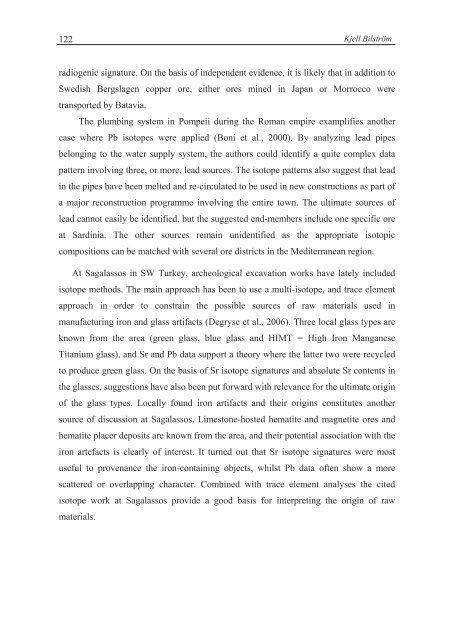instrumental techniques applied to mineralogy and geochemistry
instrumental techniques applied to mineralogy and geochemistry
instrumental techniques applied to mineralogy and geochemistry
Create successful ePaper yourself
Turn your PDF publications into a flip-book with our unique Google optimized e-Paper software.
122 Kjell Bilström<br />
radiogenic signature. On the basis of independent evidence, it is likely that in addition <strong>to</strong><br />
Swedish Bergslagen copper ore, either ores mined in Japan or Morrocco were<br />
transported by Batavia.<br />
The plumbing system in Pompeii during the Roman empire examplifies another<br />
case where Pb iso<strong>to</strong>pes were <strong>applied</strong> (Boni et al., 2000). By analyzing lead pipes<br />
belonging <strong>to</strong> the water supply system, the authors could identify a quite complex data<br />
pattern involving three, or more, lead sources. The iso<strong>to</strong>pe patterns also suggest that lead<br />
in the pipes have been melted <strong>and</strong> re-circulated <strong>to</strong> be used in new constructions as part of<br />
a major reconstruction programme involving the entire <strong>to</strong>wn. The ultimate sources of<br />
lead cannot easily be identified, but the suggested end-members include one specific ore<br />
at Sardinia. The other sources remain unidentified as the appropriate iso<strong>to</strong>pic<br />
compositions can be matched with several ore districts in the Mediterranean region.<br />
At Sagalassos in SW Turkey, archeological excavation works have lately included<br />
iso<strong>to</strong>pe methods. The main approach has been <strong>to</strong> use a multi-iso<strong>to</strong>pe, <strong>and</strong> trace element<br />
approach in order <strong>to</strong> constrain the possible sources of raw materials used in<br />
manufacturing iron <strong>and</strong> glass artifacts (Degryse et al., 2006). Three local glass types are<br />
known from the area (green glass, blue glass <strong>and</strong> HIMT = High Iron Manganese<br />
Titanium glass), <strong>and</strong> Sr <strong>and</strong> Pb data support a theory where the latter two were recycled<br />
<strong>to</strong> produce green glass. On the basis of Sr iso<strong>to</strong>pe signatures <strong>and</strong> absolute Sr contents in<br />
the glasses, suggestions have also been put forward with relevance for the ultimate origin<br />
of the glass types. Locally found iron artifacts <strong>and</strong> their origins constitutes another<br />
source of discussion at Sagalassos. Limes<strong>to</strong>ne-hosted hematite <strong>and</strong> magnetite ores <strong>and</strong><br />
hematite placer deposits are known from the area, <strong>and</strong> their potential association with the<br />
iron artefacts is clearly of interest. It turned out that Sr iso<strong>to</strong>pe signatures were most<br />
useful <strong>to</strong> provenance the iron-containing objects, whilst Pb data often show a more<br />
scattered or overlapping character. Combined with trace element analyses the cited<br />
iso<strong>to</strong>pe work at Sagalassos provide a good basis for interpreting the origin of raw<br />
materials.













